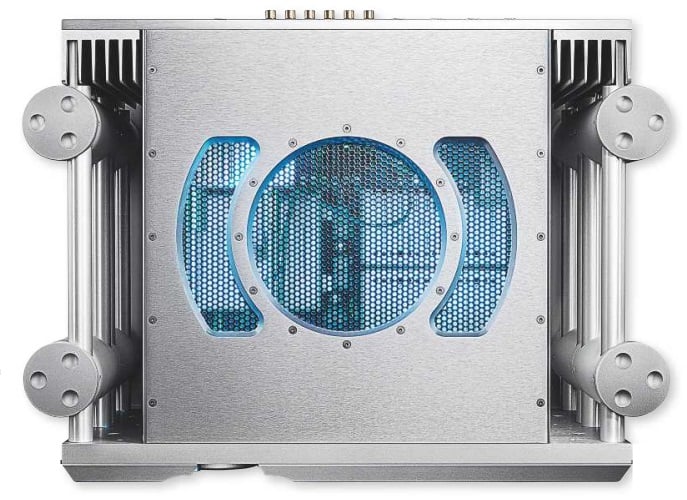
Chord Ultima Pre/Power
Pre & mono power amplifiers. Rated at 780W/8ohm Made by: Chord Electronics Ltd, Kent Supplied by: Chord Electronics Ltd Telephone: 02890 279839 Web: www.chordelectronics.co.uk
Joining the ‘horsepower club’. Chord Electronics rolls out its flagship pre and massive (and hefty) monoblock power amps. Does the sound live up to the imposing style? Review: Andrew Everard Lab: Paul Miller
At the risk of tempting fate, I wonder whether there’s a power output arms race going on between manufacturers. The arrival of the new Ultima power amplifiers from Chord Electronics – at apiece in either silver or black, along with the matching (and similarly-priced) Ultima preamp – suggests so. After all, their rated power of 780W/8ohm load is just north of the 768W claimed by Naim’s ‘Statement’ NAP-S1 monoblocks [HFN Jun ’ 15] – a target vaunted as ‘one horsepower’. In practice, Naim’s NAP-S 1 achieved 795W/8ohm in PM’s lab tests at the time, but it seems that in the current ultra-high-end amp scene, there ain’t no substitute for cubic inches – or something like that.
Table of Contents

RIGHT: The preamp’s proprietary switch mode PSUs are (just) revealed by the brand’s now-familiar blue LED lighting. A flagship ALPS volume control is fitted and all left/right circuits are individually screened
Of course, anyone of the ‘dab of opposite lock’ persuasion, even if only in their dreams, knows that power isn’t everything. Much more important is the way that power is put down to the road or, in hi-fi parlance, sent down to the speakers. In amplifiers as well as cars, it’s all about power and grip.
KILOWATT CLOUT
That’s certainly what Chord is claiming for its new power amps. You see, not content with that impressive 8ohm output, it claims they deliver 1400W into 4ohm and 2500W into 2ohm – the sort of power that doesn’t so much drive even recalcitrant speakers rather nicely as actually bludgeons them into submission. Or, as Chord puts it, the amplifiers ‘have been conceived for the very finest high- end audio systems, those which by their very nature, tend to have the most demanding and most difficult-to-drive large loudspeakers. They deliver unsurpassed power and are capable of effortlessly driving any speaker’ [see PM’s boxout, p32, and Lab Report, p37].
If all those suggestions of weapons- grade clout weren’t enough, the Ultima power amps have the looks to back up the threat. This is Chord’s unique industrial design rendered on the grand scale, complete with sculptural cut-outs in the solid slab-like panels, LED illumination and the company’s Integra leg system. If you’re feeling really brave or particularly strong – the amps are hefty, as well as large – you can actually buy extra legs and stack a pair of them. Or indeed stack a pair for each speaker, should you really wish.
All that power is made possible by an array of 64 proprietary MOSFET output devices in each amplifier, while the drive circuitry uses a high-speed high-voltage amplifier with advanced feed-forward and feedback compensation. More of the design thinking and the legend behind it in PM’s interview with Chord MD, Franks [p35]. Otherwise, the reality here is
‘The preamp has all Chord’s styling cues cranked up to 11′
of a pair of massive power amps, complete with some unusual features.
POLE STARS
A glance at the rear panel, with its pairs of balanced and single-ended inputs, plus two sets of speaker terminals, might lead you to think this is a stereo design. In fact, the pair of inputs offer inverted and non-inverted polarity – some other amps do this with a switch – with Chord suggesting the non-inverted inputs might offer the best sound. The twin sets of speaker terminals are just there to facilitate bi-wiring, and the only other connection is a 12V trigger input, allowing the amps to be fired-up remotely from a preamp – of which more in a bit.
The single control to the front of the power amp serves the dual function of power switch and a dimmer for the somewhat spectacular illumination provided, which has become something of a Chord signature. The power button in the centre of the control glows red when in standby, turning to green when pushed to power the amp up, then blue – or teal, as Chord would have it – when the amp is settled and ready to play, following a spot of relay clicking.
SET CONTROLS TO STUN
In all likelihood the Ultimas will be sold as a trio with the partnering preamp, which takes all the Chord Electronics styling cues and cranks them up to 11. In simple terms, this is a preamp with four balanced and four unbalanced line inputs, plus an AV bypass input, and three sets of outputs, again on both RCAs and XLRs. But you know it’s not going to be as simple as that as soon as you look at the size of the thing, and its array of controls. Not only is there a very large volume control and a smaller knob for balance, but four more adjusters for tone control, with separate low- and high-frequency selection for each channel.
I was reminded of the tab controls inside a WWII fighter or those adjusting the heater in a post-war sports car…
In some ways this makes sense, given that the preamp is a dual mono design; in others, it does give the Ultima Pre a rather fussy look, emphasising that we are some way from the simple idea of an input switch and volume control. And so the preamp proves for there’s adjustable gain for each input, and a slightly confusing ‘Bus A’ and ‘Bus B’ option, which in essence controls which input is routed to which output, so that one can be listened to while another is recorded, this blast from the past presumably brought to you by the nascent revival in the fortunes of the reel-to-reel tape recorder. Quite why ‘Bus A’ and ‘Bus B’ couldn’t be labelled ‘Listen’ and ‘Record’ escapes me – I guess that just isn’t the ‘technical’ Chord way of doing things.
Fortunately more conventional is the remote IR handset, which is a familiar looking design with a cursor section at its heart, ‘Chorded-up’ by cladding its black plastic in an aluminium sleeve. However, this off-the-shelf provenance does mean that some buttons on the remote are labelled for functions the preamp doesn’t actually offer, while others require the operation of buttons marked for entirely different purposes, meaning some familiarisation will be required. For example, the button labelled for switching outputs 1 and 2 together is actually the tone control bypass.
CHORD’S ULTIMATE
Spending time with the Ultimas in editor PM’s listening room allowed me to discover two things: one is that the amplifiers sound truly uninspiring when used ‘cold’, but that they fairly rapidly warm up to deliver
POWER PLAY
Achieving high power outputs into moderate 8 or 4ohm loads is as much about delivering a high voltage across the load as supplying the current to support it, which is why most designers opt for a bridged-mode output configuration, doubling the amplifier’s voltage capacity without complicating the PSU. Recent examples include D’Agostino’s Progression Mono [HFN Jun ’17] and Emotiva’s XPA-DR2 [HFN Oct ’18], achieving 640W and 650W/8ohm, respectively, on test.
By contrast, the architecture of Chord’s ±110V switchmode supplies allows three of them to operate in parallel, thereby ensuring the Ultima is one of very few single-ended amplifiers available in this stratospheric power range. Furthermore, as we’ll discover [see Lab Report, p37], these supplies are so tightly regulated that the Ultima’s output nearly doubles into each halving of load impedance – right down to 1ohm where it sings out to the tune of 5620W, or a clean 75A of current for short term musical peaks. The most powerful amps we’ve tested? The crown is still held by Musical Fidelity’s Titan [HFN May ’10] and Tri-Vista kW [HFN Aug ’03] – bridged designs that delivered 1050W and 1996W into 8/4ohm loads, the former achieving 5896W/1ohm (76.8A) while the Tri-Vista kW went on to drive 8820W into 0.8ohm, supported by over 100A! PM
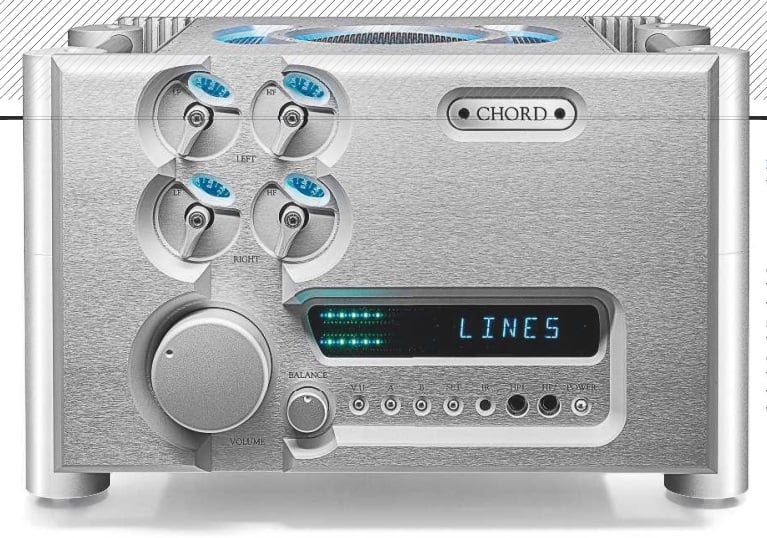
LEFT: We can’t help thinking the Ultima preamp is rather larger than it really needs to be, but the industrial design is certainly distinctive! The ‘flip’ controls top left provide separate HF and LF tone controls for each channel, while the buttons under the display could do with clearer function labelling
![ABOVE: If the Ultima power looks big and bold head-on, it’s even more so front-to-back! The single control in the centre combines on/standby and a dimmer for the usual striking Chord illumination [see picture below]: it glows red in standby, turns green during start-up, then blue in operation](https://topnewreview.com/wp-content/uploads/2019/01/Chord-Ultima-Review-3.jpg)
ABOVE: If the Ultima power looks big and bold head-on, it’s even more so front-to-back! The single control in the centre combines on/standby and a dimmer for the usual striking Chord illumination [see picture below]: it glows red in standby, turns green during start-up, then blue in operation
It’s at this point that I’ll admit my past experience with Chord Electronics amplification has led me to feel that the company’s ‘house sound’ is technically very accomplished but somewhat lacking in soul: the word ‘antiseptic’ is the one
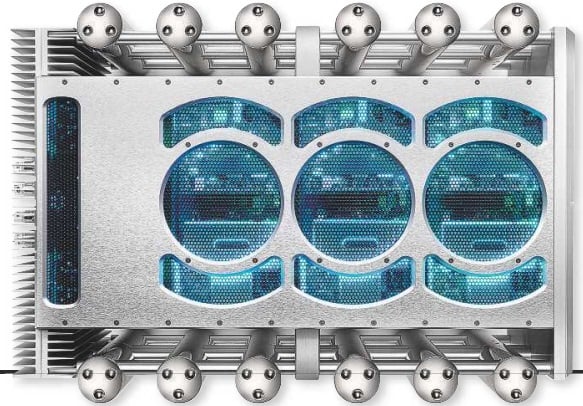
‘There’s a latent power hovering with intent in the background’
that springs to mind. I have never really felt that the accomplishments of the Chord engineers when it comes to making fine-sounding digital products – from the little Mojo pocket DAC [HFN Jan ’16] all the way up to the flagship DAVE [HFN Apr ’16] – ever quite translated into equally impressive analogue amplification.
Which was exactly what I feared on first acquaintance with the Ultima amps, until the moment when, playing ‘Yours Is No Disgrace’ from The Yes Album in DSD64 [from Atlantic WPCR 15903], my notes suddenly switched from comments such as ‘all a bit methodical’ and ‘rather technical’ to a simple ‘That’s more like it!’. Now the Ultimas sounded like a big amp totally in
JOHN FRANKS
The intent behind these flagship amplifiers is clear enough: ‘We wanted to evolve our state of the art,’ confirmed Chord Electronics’ MD and Chief Designer John Franks. ‘Our latest amplifier topology really began life in the compact Etude that we launched in early 2018. It uses a dual feed-forward error-correction amplifier technology originally conceived by Essex University Emeritus Professor Malcolm Hawksford and later refined by a young Bob Cordell from Bell labs.
Of course, it’s married up here with our high frequency (switchmode) PSU design, which has itself evolved since the mid-1980s.’
So what has enabled Chord to achieve such high outputs in the Ultima? ‘Yes, the Ultima design is the largest and most powerful of our mono amplifiers,’ says Franks, ‘this particular unit has 64 power FETs that demand our most highly advanced and refined drive circuitry, operated here from boosted ±125V rails. These PSU rails are higher the the ± 110V feeding the power FETs themselves, though the latter are 2kW supplies [4kW burst] designed to deliver huge current swings.’
And the cool running – how has this been achieved without significant visible heatsinking? ‘By combining the Hawksford/Cordell error amplifier technology with our custom lateral MOSFETs, we’ve been able to reduce the standing current right down to just a few milliamperes in each pair of output devices. As a result our Ultima amplifiers are just barely warm to the touch when idling.’
![LEFT: The preamp [top] offers eight line ins (four on RCAs and four on XLRs), two tape ins (on RCAs), one AV bypass input/ output (on XLRs) and three sets of main outputs (on RCAs and XLRs). The power amp [below] has inverting and non-inverting single-ended (RCA) and balanced (XLR) inputs with two sets of speaker outputs on 4mm binding posts](https://topnewreview.com/wp-content/uploads/2019/01/Chord-Ultima-Review-5.jpg)
LEFT: The preamp [top] offers eight line ins (four on RCAs and four on XLRs), two tape ins (on RCAs), one AV bypass input/ output (on XLRs) and three sets of main outputs (on RCAs and XLRs). The power amp [below] has inverting and non-inverting single-ended (RCA) and balanced (XLR) inputs with two sets of speaker outputs on 4mm binding posts
Mind you, you don’t have to crank these amps to serious levels to hear them at their best, however tempting that sense of unstoppable power might be. Playing the delicate theme from ‘Letters From Iwo Jima’ on Kyle Eastwood’s Time Pieces [Jazz Village JV 570034; 44.1 kHz/24-bit] the Ultima trio shows its combination of finesse and precision, with an especially impressive resonance on Eastwood’s bass.
And they pull off the same trick with ‘Wild West End’ from the first Dire Straits album [in DSD64 from Vertigo UIGY-9032]. Here the laidback balance is served well by the tight, clean rhythms, plus the guitars have fine snap with a real sense of strings being struck.
BEFORE SINATRA
Nevertheless there are times when the Chord combination can still sound a little too clean for its own good, for example with Count Basie’s ‘Corner Pocket’ from the Live At The Sands (Before Frank) set [MFSL UDSACD 2113]. Here the sound is tight and rhythmically focused, but just a bit more lushness in that massed brass wouldn’t go amiss. Similarly Masaaki Suzuki’s reading of the Prelude and Fugue in C major, from his second volume of Bach Organ Works [BIS-2241, SACD] has a superb sense of the recorded acoustic and the roles of the component parts of the instrument, even if the sense of ‘puff and pipe’ is downplayed a bit.
No amplifier is perfect, but Chord’s Ultima pre/power is undoubtedly impressive on so many levels. Indeed, the way these monoblocks got hold of Bowers & Wilkins’ own flagship speakers suggests the company’s claims of control could be justified. Meanwhile the killer combination of all-out slam, speed and subtlety means they will be well-suited to a very wide range of musical styles (and indeed volume levels).
They’re happiest when working hard, without a doubt, but then with this amount of power on tap, you’d have to be going some to even start exploring their limits. (!)
VERDICT
LAB REPORT
CHORD ULTIMA PRE/POWER
Chord’s Ultima preamp offers six levels of overall gain: ‘0.5’, ‘1.0’… ‘2.5 and ‘3.0’ amounting to 0dB, +5.6dB, +10.2dB,
+ 12.3dB, +14.2dB and +15.6dB, balanced in/out, respectively. Maximum output level is 10.6V regardless of gain, from a 96ohm source impedance, while the S/N ratio is slightly below average at 83dB (re. 0dBV), a feature it shares with the Ultima power amp(s) with their 79dB A-wtd S/N (re. 0dBW). Incidentally, both amplifiers have a ‘smooth’ noise floor – decades of lab test data indicating a correlation between amplifiers that show a finite level of ‘white’ noise and those preferred on listening tests… The preamp’s response, meanwhile, is flat to within ±0.1 dB from 1 Hz-100kHz with the EQ facility disabled, and ±5dB/10kHz and ±5dB/20Hz (all re. 0dB/1 kHz) with the HF/LF EQ controls enabled and rotated to maximum/minimum.
The partnering Ultima power amp did not quite make its continuous 780W/1400W 8/4ohm power rating – 690W/1305W was nearer the mark at < 1% THD – but the 0.2F of low-ESR reservoir capacitance and three ±110V PSUs operating in parallel delivered a stupendous 825W, 1595W, 3041W and 5617W into 8, 4, 2 and 1ohm loads under dynamic conditions [see Graph 1, below]. Into 8ohm loads, distortion is well managed at 0.001%/1 W, 0.0012%/10W and 0.0018%/100W up to just 0.004%/600W (all at 1kHz). THD increases by a factor of ~10x at 20kHz, but remains lower overall than the preamp at 0dBV [see Graph 2]. Commensurate with an output impedance that increases from a low 0.016ohm/1 kHz to 0.08ohm/20kHz and 0.9ohm/100kHz, the response rolls gently away at HF to -0.7dB/20kHz and -2.9dB/100kHz (10W/8ohm).
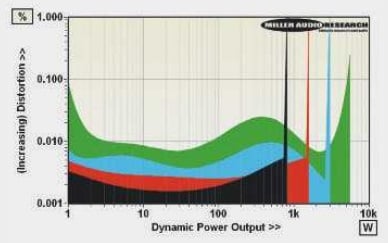
ABOVE: Dynamic power output versus distortion into 8ohm (black trace), 4ohm (red), 2ohm (blue) and 1ohm (green) speaker loads. Max. current is 74.9A
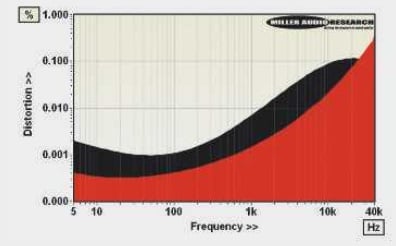
ABOVE: THD vs. extended freq for Ultima pre (1V out, black trace) vs. Ultima monoblock (10W/8ohm, red)
Specifications
| Continuous power (<1% THD, 8/4ohm) | 687W / 1305W |
| Dynamic power (<1% THD, 8/4/2/1ohm) | 825W / 1595W / 3041W / 5617W |
| Output imp. (20Hz-20kHz. pre/power) | 96-99ohm / 0.016-0.090ohm |
| Freq. resp. (20Hz-100kHz. pre/power) | +0.0 to -0.15dB / +0.0 to -2.9dB |
| Input sensitivity (for OdBV/OdBW) | 1000mV (pre) / 96mV (power) |
| A-wtd S/N ratio (re. OdBV/OdBW) | 83.3dB (pre) / 78.5dB (power) |
| Distortion (20Hz-20kHz. 1V/10W) | 0.0009-0.11%/0.0003-0.072% |
| Power consumption (preamp) | 22W |
| Dimensions (WHD. Pre/Power) | 480x310x355/480x310x670mm |





